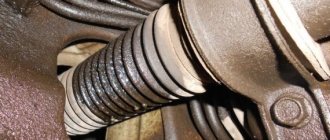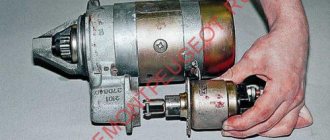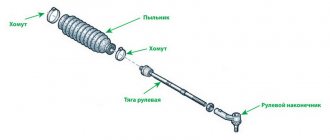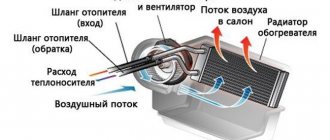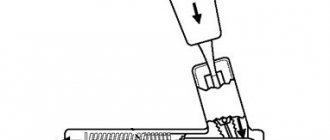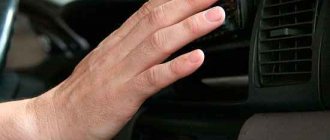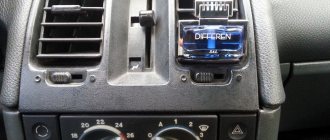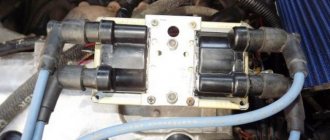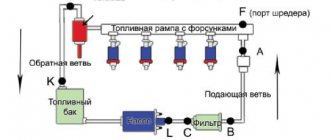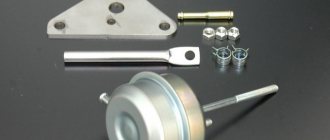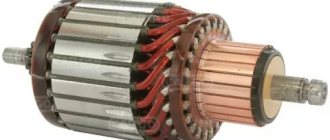TOP 5 reasons why the car steering wheel knocks when driving!
1. Knock in the steering wheel on uneven roads when driving straight.
Sometimes a knock occurs when driving on an uneven road. The cause may be worn-out shaft bearings located inside the steering column. As a result, radial play of the shaft occurs, accompanied by this knocking sound. If the O-ring or retaining ring is worn, this can also lead to end play. This can be partly solved by inexpensive repair of the column due to the provided supply of necessary spare parts.
Along with replacing faulty elements, specialists also replace related elements and parts that may be serviceable, but soon will probably again require repair of the entire assembly due to their failure while driving.
Some car models have a non-removable column that cannot be restored. In this case, the entire column changes.
2. Knock when turning the steering wheel while standing still or in motion
First of all, it is worth checking the tire pressure - differently inflated wheels can also cause knocking noise when the car is moving. Next, inspect the fastening of the plastic fender liners. Probably, one or more mounting screws have broken out, which is why the fender liner touches the wheel when turning and makes a corresponding knock. The problem can be easily fixed. You just need to replace the loose fasteners with new ones.
The greatest danger is caused by malfunctions accompanied by a knocking sound from the steering mechanism itself when turning the steering wheel. The sound may be localized closer to the suspension, wheels or steering wheel. Let's look at the reasons for its occurrence, starting with the most common.
3. Constant velocity joints
A knocking sound when the steering wheel is turned while driving is usually associated with the operation of the outer CV joint, which begins to creak or, in some cases, hit the wheel. Accordingly, when turning left, a crunch or knock will occur in the right CV joint, and when turning right, in the left one.
Internal hinges, as a rule, make a squeaking or knocking sound when moving at high speed over uneven surfaces. They do not react at all to steering wheel turns. Therefore, if turning or sharp acceleration of the car is accompanied by a knocking noise, most likely the outer joint needs to be replaced. But before replacing it, you should carefully inspect it. If there is little or no wear, it is enough to treat the CV joint with appropriate lubricant.
4. Tie rods and tie rods
Both the tips and the rods in the steering system wear out over time, causing play. As a result, squeaks and knocks appear when the car turns while driving.
To check the condition of the parts, jack up the car on the side where the sounds are coming from and remove the wheel. Then try to loosen the rods and tips, thus checking for possible play. Often, dirt and water accumulate inside the tip due to a torn boot, which is why the knocking occurs.
Sometimes a distinct metallic knock when turning the steering wheel in a stationary car or while driving appears due to the fact that the car owner forgot to secure the tie rod with the end after performing a wheel alignment. You can verify this by shaking the wheel left and right with your hands. If the wheel wobbles, making a characteristic sound, the problem is precisely the loose nut.
5. Steering rack
A faulty steering rack quite often causes knocking noises when turning the steering wheel, both while driving and when the car is stationary. Why does this knock occur? There are several reasons for this:
- The steering gear fasteners are not tightened properly.
- The plastic support bushing of the steering wheel was severely worn, creating play.
- Play appeared in the steering rack shaft bearings.
- The gap between the rack teeth has increased, creating backlash and causing dull knocks when turning the steering wheel on a stationary car.
- The anti-friction gasket was completely worn out, as a result of which the clamping “cracker” began to vibrate and knock on the steering rack housing.
Detecting a knock in the steering rack is a rather difficult task. It is best to use the help of a partner by asking him to sit behind the wheel of the car, previously placed on the handbrake, and position himself under the car near the steering rack. Let the assistant rotate the steering wheel, and at this time you note the creaks and crunches coming from the rack, which will signal a malfunction.
Subscribe, comment, like!
Useful materials about cars
here!
Diagnostics
If knocking occurs in the steering wheel, perform a comprehensive diagnosis of all structural elements. Checking with the engine turned off using an inspection hole will help you determine the existing damage, as well as decide how to correct the cause of the knocking noises - yourself or in a service center.
Manipulating the steering wheel by turning it left and right all the way will allow you to determine:
- approximate condition of all fastening elements of the mechanism;
- the presence of various backlashes in the steering rod joints;
- detecting knocking in the steering wheel, as well as its jamming.
If the knocking does not disappear after the procedures performed, it will be necessary to dismantle the swing arms and transverse rods, followed by troubleshooting or replacement of broken parts. Diagnosing the true cause of the rack knocking when turning will allow you to “heal” the mechanism on your own or resort to the help of automobile mechanics. It is possible that you will have to fork out for a separate unit or even completely replace the mechanism.
Of course, you need to carefully weigh all the pros and cons. Also because replacing the entire rack will cost a pretty tidy sum. But here, again, it is important to understand that the new original rack will have a much longer service life than a restored one. In addition, this will have a positive effect on the behavior of the car and, as a result, on traffic safety.
Why is the steering rack knocking?
- Insufficient fixation of all fastening connections. In order to correct the situation, tighten the bolts and nuts;
- the support sleeve could potentially be worn on a certain side. This may be due to the formation of play due to driving on poorly paved roads. All kinds of noises and knocking in the steering column can appear because of this.
- a corroded bushing is one of the causes of backlash. Then, you need to completely change the steering rack;
- potential wear of all kinds of rubber covers (anthers), which serve as protection against dust and dirt - this leads to the formation of dirt inside the rack itself, and can seriously damage the mechanism and sliding supports;
- Bushing wear may be caused by the use of an unnaturally soft material used in manufacturing. This leads to deformation of the bushing when the car is driven on poorly paved roads. The problem can be solved by independently turning a new bushing, which will be made of a material stronger than the original one. As an example - caprolon. Independent work will eliminate the need to purchase a new spare part, which will save a significant amount of money;
- tooth wear.
Causes of steering rack knocking
If the steering rack is knocking, there may be several reasons:
- The steering wheel fastenings are loose.
- The plastic support sleeve has worn out and a backlash has formed.
- Play in the bearings of the input shaft.
- Due to wear, the gap between the teeth of the steering rack has increased, which led to play and a dull knock.
- The clamping block is loose and knocks on the steering rack body due to wear and tear of the anti-friction lining.
Hover your mouse over the detail of interest on the interactive image
It is important to determine where the knocking is coming from . While driving, it may seem that the steering rack is knocking, but the problem could also be in the tie rods or steering tip. By the way, you can determine that the tip is to blame by looking at the torn boot.
Consequences of knocking in the steering rack
The severity of the consequences will directly depend on how quickly the driver pays attention and starts repairing. Every kilometer of delay leads to negative consequences and excessive wear of adjacent parts. There are frequent cases when owners contact a car repair shop with a request to carry out a major overhaul of the unit, although the initial cause was a normal knocking noise in the front axle area. Having ignored the car’s signals about a breakdown, the owner will have to shell out 2–3 times more financial resources for repairs than could have been the case.
Critical phases of knocks develop into road accidents, driving into ditches, roadsides, collisions with oncoming cars, and fatal outcomes for road users.
Cost of repair
There is no definite answer, since the final price of the repair will be clear during the inspection. The final price is also affected by the brand, model, service life, type of steering rack, complexity of the mechanism, and place of repair.
How to protect the rack from knocking
To avoid steering rack malfunctions and prolong its life, you should give up reckless driving through potholes on turns, if this is practiced. The habit of sharply accelerating and braking at the last moment is also very harmful to the steering rack. This happens because if the front drive wheels are loaded with traction or braking torque, then impacts from bumps coming to the steering wheel become much more sensitive.
Often the steering rack becomes unusable due to careless parking. Using a curb as a bumper results in high loads on the wheel at an angle of 45 degrees. A deadly shock is transmitted to the steering mechanism and provokes chipping of the gear.
Regular preventive inspections, replacement of loose parts and damaged boots will help extend the life of the steering rack. This is why some drivers regularly face steering gear repairs, while others drive quietly for years.
How to identify faulty or worn steering tips?
A rack or gear mechanism is responsible for turning the front wheels of the car. The unit simultaneously transmits force to both steering knuckles through rods with hinges at the ends. These 2 parts are the weak link of the control system - the service life is 20–80 thousand km, depending on the make of the car and operating conditions. Car enthusiasts should learn to recognize the signs of faulty steering tips in time, since their technical condition is directly related to the safety of passengers.
Tie rod design
In order to independently determine the degree of wear of the tips, you need to at least understand their structure in general terms. The rod is a metal rod with a thread at one end and a hinge at the other. The threaded part is used to connect to the rack or gearbox, and the ball pin is inserted into the eye of the steering knuckle and secured with a nut.
The wear of the steering tips implies the wear and tear of the hinge itself, which consists of the following parts:
- cylindrical body, closed on one side with a plug;
- a ball pin resting its lower part on the supporting heel;
- a spring is installed at the bottom between the fifth and the plug;
- An insert made of wear-resistant plastic is provided between the body and the ball;
- The top of the case is covered with a rubber or silicone cover.
Note. Depending on the design of the rods for a particular car brand, the metal rod can be welded to the hinge body or screwed onto a thread.
The plastic liner allows the ball pin to rotate in different directions, and the spring selects the play that appears during operation. When a fault is detected in the steering tips, the parts are usually replaced, preferably in pairs. There are also collapsible hinge designs that allow you to change a worn-out insert, but they are unreliable in operation.
How does the steering linkage knock?
Hi all. Please tell me, on the right side I can hear a knocking on a bump, but not frequently. At the diagnostics they said it was a pull rod, I changed both rods and at the same time the ends, but the right link was bent, the knocking became quieter, after some time it began to be heard again, but even stronger. I I know that the rake is a weak point on the beads, how can I tell if the rake is there or not? Is it possible to tighten it?
Harmful Gin
, Scroll lower to start. Don't worry
Harmful Gin
, go again for diagnostics only to other specialists. Listen to what they say. draw conclusions
And the damn thing on my right side has been knocking for two months now, I still can’t figure out where. I also started thinking about something about the rack. I’ve already changed everything on the levers.
And I have a knock on the right side. Moreover, at the service station diagnostics they said that the suspension is ideally a rack type!
The first sign of a truly broken rack is that it is leaking, knocking, the steering wheel is spinning, there are a lot of topics in the search.
Alternatively, the front stabilizer bushings are knocking))
go to others? So you can drive for a long time and change half a car!
For a long time? How long did it take you after the replacement? I have it in 10t.km. upper lane the right one rattled. Changed both
And I have a knocking sound on the right front, I changed the levers, but I still don’t understand that it’s knocking, it’s knocking at slow speeds and small bumps.
— Added a little later —
Does this look like a disease? Before that, it was the same on the previous Passat, so I sold it, they didn’t find what was knocking and it was on the RIGHT FRONT
Alternatively, hang up the front wheels and dynamically turn the wheels left and right. You should hear how and where the rack knocks.
igor71
,
Check the shock absorber support bearing. I changed everything and it turned out to be IT.
The rack does not leak and does not bite, the mileage is barely gaining one and a half thousand, all diagnostics that can be bypassed, The question is whether the rack is pulled or not.
there are no bearings, the suspension is not the same, the shock absorber does not rotate when you turn the steering wheel, there is only a support!
nikola_
, absolutely right, but according to the catalogs it is called a support bearing, although in fact there is no bearing
maybe the Russian can tap?
Cezar35
, on turns maybe
how did it sound to you? otherwise I have a blow from below to the body in good holes, they can’t find it
SADOR
,at first the knocking was only in large pits and distinct, as if it was hitting the body, later it was heard in any pits, I changed everything that was possible, the last master said to change the shock absorber, when they untwisted it, it was a complete fuck-up, the shock absorber support was completely broken and the metal part of the support hit the upper part of the strut (spring compression cover).
Causes of joint wear
During operation, the working pair of the tip (plastic insert and ball pin) experiences loads from the steering rack, which pulls or pushes the steering knuckle depending on the direction of movement of the car. Another type of load affects the element from the side of the wheel falling on uneven road surfaces.
In the first case, the force is applied perpendicular to the axis of the ball pin and acts on the fracture; in the second, the forces tend to pull the part out of the socket. There is a third type of load - the friction force that arises in the unit when the wheels turn. Since the finger is rigidly fixed in the eye of the fist with a nut, it rotates inside the plastic bushing and rubs against its walls.
Due to the impact of these loads, the hinge joint wears out as follows:
- Over time, the walls of the liner wear out, a gap forms between them and the ball, which is why a quiet knock is heard when moving over small uneven surfaces.
- Abrasion of the side walls of the bushing leads to loosening of the pin, because it is pressed by the spring only from below.
- When the spring and heel are unable to remove the play resulting from wear of the plastic, the ball pin moves easily in the bushing, causing the steering tip to knock heavily.
Important point! Hinge joints have an external enemy that significantly reduces the resource of the working pair. This is dust and moisture that penetrates between the rubbing surfaces as a result of the rupture of the upper rubber cover.
Such defects must be identified in a timely manner, otherwise the damaged tip will quickly become unusable.
In cars equipped with a double-wishbone front suspension, sometimes a breakdown occurs that is not related to the operation of the hinge. Since the rod is located low, if you drive carelessly on bad roads, the metal rod can bend when it hits a stone or other obstacle. In this case, knocking does not occur, but other symptoms are observed, described below.
Symptoms of malfunctions
If you do not pay attention to the wear of the tie rod ends, the ball pin will become loose and jump out of its socket at the first decent bump. There is no need to explain for a long time what this entails: the wheel will become uncontrollable, and the driver will lose control of the car. How to determine that there are problems with the hinges and the car’s chassis needs to be checked:
- the first sign is a dull, frequent knocking sound when driving over small bumps, especially in turns;
- as a rule, extraneous sounds are heard from one side, but simultaneous wear of two tips also occurs;
- the free play of the steering wheel increases;
- when negotiating a turn on an uneven road, you can feel a tapping sound on the steering wheel;
- At the last stage of wear of the tips, the car has to be literally “caught” on the road, since due to the play of the ball pins, the wheels can deviate by 2–3° from the straight line.
Note. Unfortunately, such signs are observed not only as a result of problems with the steering rack, but also as a result of wear of the bearing of the rotary bipod and the pendulum. The exact result will be shown by a check performed by car service employees or independently in a garage.
If you find one of the listed symptoms in your own car, you should not delay diagnosis. Especially if the tips have served more than 40 thousand kilometers. To perform the check, you will need an inspection ditch; hanging the car on a jack will not allow you to swing the rod in the desired direction.
To check the tie rod ends yourself, use the step-by-step instructions:
- Drive the car exactly in the center of the inspection hole so that you can easily reach the hinges. If the ditch is too narrow, the car will have to be moved twice in different directions.
- Support the rear wheels with wheel chocks.
- Grab the rod with your hand as close to the tip as possible. Rock the hinge up and down to feel the play.
- A small elastic resistance indicates that the spring is working and there are no critical gaps. Significant play is felt immediately.
- Rotate the rod several times around its own axis. If it flows easily, literally dangling on the ball pin, the tip should be replaced.
Advice. When swinging the rod, do not confuse the hinge play with free play of the steering rack or a broken pendulum bearing.
To check the integrity of the anthers, an inspection hole is not needed. It is enough to turn the wheel and lift the car with a jack. The hole in the rubber boot is discovered thanks to thick lubricant, which is squeezed out from the inside through a gust.
Replacing the steering tip is also not a big problem; the only special tools you need are a puller to push the ball pin out of the steering knuckle eye. Please note an important nuance: after replacing the linkage, the camber angles of the wheels must be adjusted. You cannot make the adjustment yourself, so you will have to visit a car service center.
Signs of a faulty steering rack
Most cars are equipped with hydraulic booster (power steering) or electric power steering (EPS). The main faults of the steering rack are similar in them, but there are also differences, so it makes sense to consider them separately.
Power steering rack malfunctions
Symptoms of a faulty steering rack with power steering are often associated specifically with the hydraulic system - fluid and pump. So, if a hydraulic rack breaks down, the driver will feel:
- Increased effort when turning the steering wheel. In other words, the steering wheel becomes “heavy”, and if you could literally turn it with one finger, now you need to make significant efforts to turn it.
- Regular decrease in power steering fluid level in the expansion tank. This is indicated by a corresponding lamp on the dashboard, fluid leaks under the car or on elements of the engine compartment.
- Knock when driving. It is especially clearly expressed when driving on uneven roads.
- When turning the steering wheel, a strong hum is heard. And the more the steering wheel is turned (no matter in which direction), the louder the noise becomes. Often the hum is accompanied by a slight vibration of the steering wheel.
- After turning the steering wheel, it slowly or does not return to its original position.
- When the car moves straight, the front wheels do not maintain the trajectory, which is why the car “fidgets” along the road.
This is interesting: OBD2 error code P0500: speed sensor malfunction
Electric steering rack malfunctions
In general, electric rack malfunctions are similar to hydraulic rack problems, except for fluid leaks. So, when a rack with an EUR fails, it often happens:
- knocking noise when turning the steering wheel;
- biting the steering wheel;
- uneven force on the steering wheel;
- spontaneous rotation of the steering wheel;
- The red steering wheel icon is lit on the instrument panel.
In general, electric rack malfunctions are similar to hydraulic rack problems, but they are caused by slightly different reasons, which will be discussed below. The main problem in this case is water that gets onto the rod or into the rack control unit.
A working steering rack is your safety.
If there is a knocking sound at the bottom of the car and a slight beating is felt on the steering wheel, then, as a rule, this indicates that there is a malfunction in the steering. The defect is very serious, since the reliability of the car and your life depend on it. At the same time, the joy is not added by the fact that this assembled part is quite expensive - on imported cars the price starts from 1,500 US dollars, and the replacement work is approximately the same amount, sometimes less, sometimes a little more. Imagine that you ended up with a hundred thousand rubles.
How to determine why the steering rack is knocking?
There are two options for answering this question - go to a car service or crawl under the car yourself. If you choose self-diagnosis, the examination sequence will be as follows:
- Turn off the engine, put the car on the handbrake and put a helper behind the wheel.
- Climb down to the place where the rack is located and ask the person at the top to turn the steering wheel in different directions.
- Carefully inspect all protective boots (rubber corrugated products) for their condition. If you notice damage or lubricant leaks, pay closer attention to these places - most likely, the malfunction will be there.
- Try to determine by ear where the knocking comes from.
- After this, you can proceed directly to repairing the faulty unit.
If you are unable to determine the location of the malfunction, contact a specialist.
Checking the steering rack
Knocking in a car can occur for several reasons. Many motorists ask how to determine a knock in the steering rack. You can do this in the following ways:
- Visually and audibly. You may hear superficial and internal knocking. The first occurs due to a ruptured boot. In this case, the tip is not protected in any way, so it quickly fails. An internal knock indicates a more serious breakdown, which is best diagnosed at a car service center.
- Check if there are any gaps in the steering rod joints.
- Disconnect the cross rods. If the knocking noise remains, then the problem is in the steering rack.
It is recommended to put the car on a lift or pit, and then ask someone to turn the steering wheel. Being directly under the car, you are more likely to be able to determine the source of the sound.
When purchasing a used car, diagnostics can become more complicated. The damage will be difficult to determine, since the previous owner may have completely replaced the boots with new ones, leaving the underlying problem without a solution. In such situations, it is better to completely dismantle the entire structure.
What can I do to make the steering rack stop knocking?
If the tips are to blame, then repairs will not be very expensive at any auto repair shop. It is better not to do this work yourself if you do not have the skills and tools. You can only adjust the wheel alignment yourself.
If the knocking comes from the side of the connection between the steering rack and the rod, then you can eliminate the defect with your own hands. The sequence of this procedure:
- Remove the protective boot and remove the grease.
- Replace the bushing if it is damaged. The fact is that this part is made from fluoroplastic, which is a rather soft material, so such a defect occurs often.
- Clean the spring from dirt and sand; if necessary, remove it and wash it with a special liquid or solarium.
- Replace the boot even if there are minor cracks or tears.
- Tighten the bolt that controls the movement of the bushing. It should be remembered that there is no need to apply much force, otherwise the entire mechanism may be damaged.
Finally, assemble all the steering components and check how it works; if the knocking noise disappears, then everything is normal, and you have saved about a hundred thousand rubles. If the rack itself is damaged, it will have to be replaced.
Why does the steering rack knock and how is it repaired?
Similar articles
- Spring chassis maintenance. What you should pay attention to.
- How to choose a good ball joint and install it correctly
- Pandora or Starline: choice of alarms up to $350
How often do you hear a sad phrase from Honda drivers: “My steering rack is rattling, I’ll probably have to change it... isn’t it expensive?” I always want to answer such questions with joy: “ Very dear! ”at the same time, without deceiving the person at all. Indeed, the steering rack, or steering gear, is a very, very expensive component of a car. It happened that the price charged by the supplier for this part reached a quarter of the real cost of the car on the market. After announcing it to the client, often in his eyes there was a strong desire to engage in “self-depilation” of different points of the body, and no wonder - for example, for a Honda H-RV, the cost of the steering gear assembly is more than 50,000 rubles with a delivery time of more than a month!
What then is our joy when such a question arises? Do you think in a thirst for profit? You are wrong, dear ones! Now we will tell you how to get rid of a knock in the Honda steering rack, at least on your own, and at maximum, by returning to the service center that diagnosed you with a rack replacement, and victoriously pointing them at this article, you will indicate the correct course of action.

